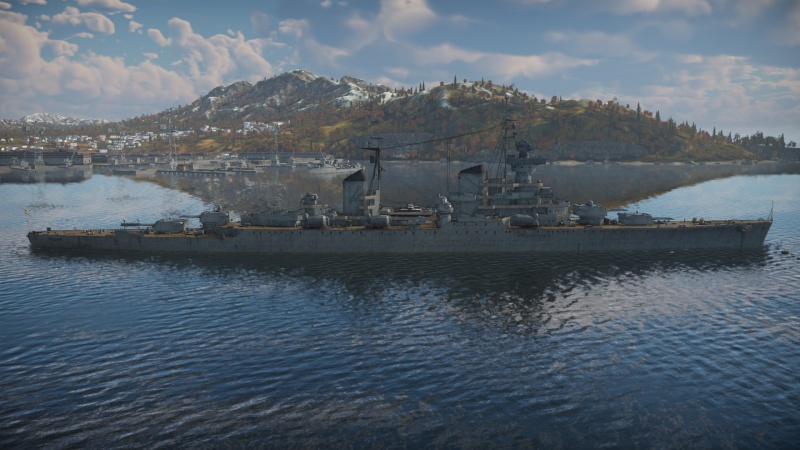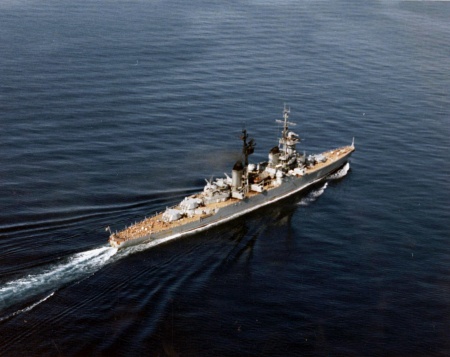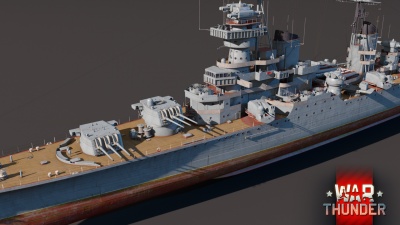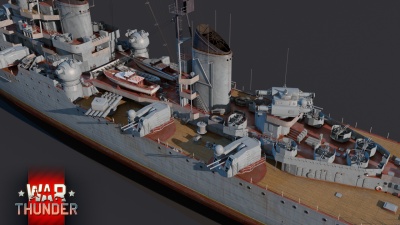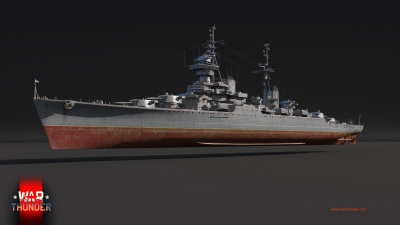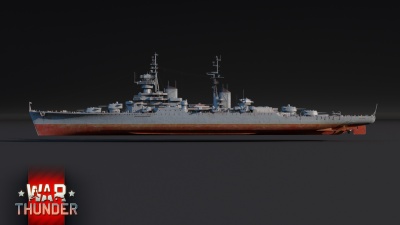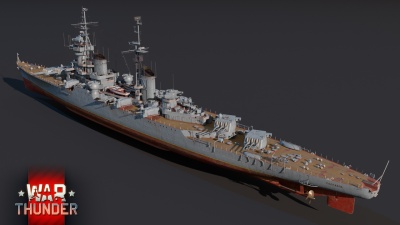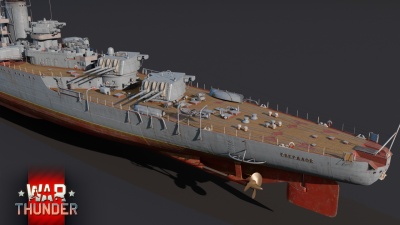Sverdlov
Contents
Description
The Pr.68-bis, Sverdlov, 1952 was the lead ship of the Sverdlov-class light cruisers, the last conventional gun cruisers built for the Soviet Navy. They were modified and enlarged versions of the Project 68-K Chapayev-class light cruisers. Sverdlov was laid down on 15th October 1949 and commissioned on 15th May 1952. Unlike the Chapayev class, the Sverdlov was built with two quintuple 533 mm torpedo launchers on each side of the hull, with two spare torpedoes for each launcher. The anti-aircraft armament was also strengthened as Sverdlov gained two additional pairs of 100 mm twin turrets as well as two 37 mm twin V-11 autocannon turrets. Despite their size and displacement, the maximum speed was an impressive 32.5 kn (60.2 km/h). Sverdlov spent most of her career performing ceremonial visits to allies and non-allied ports. She also underwent several refits giving her air and surface search and track radars as well as ECM equipment that changed over the years. She was decommissioned after her first refit in 1966, then reactivated again in 1972. She was decommissioned for second time in 1977 following a refit and placed into long term storage in 1978 where she remained until 30th May 1989 when she was decommissioned. She was towed to Kronshtadt in 1990 and sold for scrap the following year, she was broken up in 1993 in India. One of her sisters, Mikhail Kutuzov, is the only surviving ship of the class, preserved as a museum ship in Novorossiysk.
Sverdlov was introduced in Update 1.97 "Viking Fury". Her armour protection is a significant improvement over the previous Project 26 class, which the Project 68 and 68-K design comes from, as well as having guns with higher rate of fire, although at cost of penetration characteristic. Her anti-aircraft protection suite was expanded with thirty-two 37 mm automatic V-11 cannon barrels as well as twelve 100 mm dual purpose guns. Just like Chapayev, her magazines are close to waterline being more vulnerable to being hit, leading to fatal explosion.
General info
Survivability and armour
While the Sverdlov's armour is not enough to protect from high-calibre semi-armour-piercing and armour-piercing shells, it is still enough to prevent major damage from being easily inflicted by every shell that comes your way.
HE from cruiser-calibres or lesser will have trouble damaging anything below the main decks, as the main battery ammunition, engines, and transmissions are all protected by a main belt of 100 mm rolled homogeneous armour. The front and rear belt armour are only 20 mm and 30 mm thick RHA; while this isn't very useful, there is also not much in those areas that can be damaged besides the steering gear in the stern. The ammo elevators are protected by 130 mm RHA, while the turrets themselves have 175 mm on the turret face, making them heavily armoured. The turret sides and rear are much thinner but this isn't a major problem as long as the main batteries are kept pointed towards the enemy. Secondary batteries have 20 mm thick antifragmentation armour, which is only useful against smaller autocannons and strafing aircraft. Anti-aircraft batteries have no armour at all and are often knocked out, so avoid repairing them if at all possible while duelling an opponent. The conning tower has 130 mm of armour surrounding it, but the roof and floor are considerably thinner, meaning the bridge can still be knocked out by rounds exploding above and below it.
The Sverdlov's armour is most effective when angled and in order to angle the ship as sharply as possible while keeping all main cannons on target, you'll have to point the bow of the vessel away from the enemy. The armour is in no way capable of resisting even the smallest calibre of a battleship's main battery, avoid being targeted by them as much as possible.
Mobility
The Sverdlov class, despite being several thousand tons heavier than the previous Chapayev-class, performs quite similarly due to the vessels increased engine power, which enable it to match its lighter predecessor. It is fast for a cruiser of its size, its top speed being quite impressive for a vessel that weighs almost as much as a dreadnought. The ship is fairly responsive and agile when fully upgraded, although that may be a detriment at times as the ship will keel to the side as you turn, sometimes keeling far enough to prevent you from targeting enemies on one side of the ship.
| Mobility Characteristics | |||
|---|---|---|---|
| Game Mode | Upgrade Status | Maximum Speed (km/h) | |
| Forward | Reverse | ||
| AB | |||
| Upgraded | 72 | 38 | |
| RB/SB | |||
| Upgraded | 61 | 32 | |
Modifications and economy
Armament
Primary armament
The Sverdlov is armed with the formidable 152 mm/57 B-38, which are potent and powerful fast-firing cannons. There are four types of ammunition: HE, SAPBC, APCBC, and HE-TF.
- The HE round packs 6 kg of explosive filler. Useful for combatting coastal vessels and weaker destroyers, starting fires, and create flooding on larger ships.
- The APCBC shell is an essential tool when fighting cruisers at long range, especially the heavily-armoured ones. While it has a significantly reduced explosive filler compared to the other rounds, it has by far the most penetration. While using APCBC, aiming at critical components is crucial. Ammunition, engine compartments, and any other critical components are to be targeted while using this round as the reduced filler will not cause as much damage. While it has a powerful penetration, the low filler won't inflict any meaningful damage to battleships.
- The SAPBC shell is a shell which has practically the same level of filler as the HE shell, at 5.9 kg, but it also can penetrate a decent amount of armour. That being said, the penetration becomes rather puny at longer distances, with a weak 74 mm of penetration at 10 km. This round is particularly useful when facing medium-armoured vessels at short to mid range, or vessels with fragmentation protection as this round will most of the time explode inside the hull and not immediately upon contact.
| Penetration statistics | |||||||
|---|---|---|---|---|---|---|---|
| Ammunition | Type of warhead |
Penetration @ 0° Angle of Attack (mm) | |||||
| 1,000 m | 2,500 m | 5,000 m | 7,500 m | 10,000 m | 15,000 m | ||
| OF-35 HE | HE | 50 | 50 | 50 | 50 | 50 | 50 |
| B-35 AP | APCBC | 333 | 287 | 226 | 178 | 143 | 100 |
| PB-35 SAP | SAPBC | 172 | 148 | 117 | 92 | 74 | 52 |
| ZS-35 AA | HE-TF | 62 | 62 | 62 | 62 | 62 | 62 |
| Shell details | ||||||||||||
|---|---|---|---|---|---|---|---|---|---|---|---|---|
| Ammunition | Type of warhead |
Velocity (m/s) |
Projectile mass (kg) |
Fuse delay (s) |
Fuse sensitivity (mm) |
Explosive mass (TNT equivalent) (kg) |
Ricochet | |||||
| 0% | 50% | 100% | ||||||||||
| OF-35 HE | HE | 950 | 55 | 0 | 0.1 | 6 | 79° | 80° | 81° | |||
| B-35 AP | APCBC | 950 | 55 | 0.03 | 7 | 1.69 | 48° | 63° | 71° | |||
| PB-35 SAP | SAPBC | 950 | 55 | 0.03 | 7 | 5.9 | 48° | 63° | 71° | |||
| ZS-35 AA | HE-TF | 950 | 54.23 | 0 | 0.1 | 10.1 | 79° | 80° | 81° | |||
Secondary armament
The Sverdlov is equipped with 12 dual-purpose 100 mm/70 SM-5-1. While these turrets are very similar to the 130 mm/58 SM-2-1 of the Spokoinyy, they do have reduced performance due to the smaller calibre.
This weapon system has a very high rate of fire for its calibre (roughly ~30 RPM considering it is a two-cannon mount), though it has half of what cannons like the 100 mm/55 MLE model 53 (100 mm) have (~60 RPM).
Although they are a fine patrol boat deterrent, you'll get the most use out of these turrets as heavy AA. The Chapayev already had great AA capabilities with these cannons and the Sverdlov has 4 more cannons. This gives a combined fire rate of ~180 RPM, which is ~60 RPM more than the Chapayev. With HE-VT shells, this puts up a formidable screen of air-bursting shells in the face of inbound aircraft.
| Penetration statistics | |||||||
|---|---|---|---|---|---|---|---|
| Ammunition | Type of warhead |
Penetration @ 0° Angle of Attack (mm) | |||||
| 100 m | 1,000 m | 2,000 m | 3,000 m | 4,000 m | 5,000 m | ||
| OF-55 HE | HE | 24 | 24 | 24 | 24 | 24 | 24 |
| ZS-55 AA | HE-TF | 26 | 26 | 26 | 26 | 26 | 26 |
| F-55 HE-F | HE | 73 | 63 | 54 | 46 | 40 | 34 |
| ZS-55R AA-VT | HE-VT | 17 | 17 | 17 | 17 | 17 | 17 |
| Shell details | ||||||||||||
|---|---|---|---|---|---|---|---|---|---|---|---|---|
| Ammunition | Type of warhead |
Velocity (m/s) |
Projectile mass (kg) |
Fuse delay (s) |
Fuse sensitivity (mm) |
Explosive mass (TNT equivalent) (kg) |
Ricochet | |||||
| 0% | 50% | 100% | ||||||||||
| OF-55 HE | HE | 1,000 | 15.6 | 0 | 0.1 | 1.94 | 79° | 80° | 81° | |||
| ZS-55 AA | HE-TF | 1,000 | 15.6 | 0 | 0.1 | 2.07 | 79° | 80° | 81° | |||
| F-55 HE-F | HE | 1,000 | 15.6 | 0.035 | 5 | 1.77 | 79° | 80° | 81° | |||
| Proximity-fused shell details | ||||||||||||
|---|---|---|---|---|---|---|---|---|---|---|---|---|
| Ammunition | Type of warhead |
Velocity (m/s) |
Projectile mass (kg) |
Fuse delay (m) |
Fuse sensitivity (mm) |
Arming distance (m) |
Trigger radius (m) |
Explosive mass (TNT equivalent) (kg) |
Ricochet | |||
| 0% | 50% | 100% | ||||||||||
| ZS-55R AA-VT | HE-VT | 995 | 15.9 | 0 | 0.1 | 270 | 15 | 1.26 | 79° | 80° | 81° | |
Anti-aircraft armament
As already seen in previous Soviet vessels, 37 mm autocannons are a must have. However, Sverdlov takes the 37 mm to the next level. Previous ships tended to have between 6-10 single mount 37 mm autocannons. This was changed with the Chapayev with making double mounts, increasing the number of 37 mm barrels to 28, which the Sverdlov further increases to 32.
When compared to the contemporary 40 mm Bofors AA gun, the Soviet 37 mm V-11 is very similar in performance, having about the same range, accuracy, rate of fire and damage output per shot. The V-11 falls behind when you compare the traverse speed, slower compared to the Bofors, especially when not upgraded. The V-11 can fire a much longer time than the Bofors before overheating.
Additional armament
Unlike the other Pr.68 cruisers, the Sverdlov is the only one with access to torpedo tubes. It is armed with 2 x 5-tube torpedo launchers, one located at port and the other at starboard. It uses the 53-39 533 mm torpedo. Being torpedoes, they are highly situational, but do offer the possibility to take out much more heavily armoured opponents, like battleships. They have a max range of 4 km (10 km with the torpedo mode modification) and can be used at almost point blank, the torpedo must travel 50 m at minimum to be armed. These torpedoes are one of the fastest ones seen at the battle rating (94 km/h without Torpedo Mode), making it easier to aim at long ranges. However, the speed is drastically reduced if torpedo mode is active as it trades speed for range.
Usage in battles
The Sverdlov is simply a Chapayev, but better. The potent firepower is enough to destroy a wide variety of targets but to also provide a very devastating and powerful AA coverage to allied ships, especially at long range. The Sverdlov can be used as a brawler when in CQC maps, although not recommended, it is very capable of doing so. The armour and firepower it carries is enough to match practically any cruiser you can meet in a duel.
Pros and cons
Pros:
- 12 x 152 mm cannons with highly effective ammunition
- Very effective AA suite with 100 mm VT shells and 37 mm automatic guns
- Effective armour
Cons:
- Lots of AA mounts which can be destroyed by HE splash
- After exhausting the first-stage storage of the main guns, the reload speed is significantly reduced
- Torpedoes can cause an explosion if they are hit, disabling or even sinking the ship
History
The Soviet cruiser Sverdlov was the lead ship of the Sverdlov class of light cruisers built for the Soviet navy in the 1950s. Being conventional cruisers, they were designed to function as bluewater ships with the ability to perform commerce raiding duties if required, similar to the German pocket battleships and battlecruisers. The ships inherited the hulls of the previous Chapayev class, but carried an improved armament and new sensor systems. Sverdlov was commissioned in 1952, and spent most of her operational career making visits to various foreign ports and countries. She was eventually retired in the late 1970s and scrapped shortly before the collapse of the Soviet Union.
Design and development
After the construction of the Chapayev class (Project 68), the Soviet Union began the development of an improved iteration of the ship, to be known as the Sverdlov class or Project 68bis. A total of 40 ships were intended to be built, along with the larger Stalingrad-class battlecruisers and Soviet aircraft carriers. As well, the ships were intended to be capable of commerce raiding, as shown by the conspicuous success of the German commerce raiders during World War II. As a result, the ships were the largest cruisers ever built by the Soviet navy up to that time (and largest until the introduction of the Kirov-class battlecruisers), displacing 16 640 tons. Because the Soviet Leader Stalin had been a supporter of the program, his death in 1953 saw the total number of ships cut to 14. The lead ship, Sverdlov, was laid down in October of 1949 and completed by May of 1952.
Sverdlov displaced 16 640 tons full and had a crew complement of 1,250 sailors. Her main armament consisted of twelve 6-inch (152 mm) guns in four triple turrets, similar to the British Crown Colony-class and American Cleveland-class. Despite this, the Sverdlovs were still inferior in armament to the American Baltimore-class and Des Moines-class cruisers that were then in service. The ships had a heavy anti-aircraft battery of twelve 100 mm guns in twin turrets, and 32 x 37 mm anti-aircraft guns in twin turrets. The ships also carried two quintuple torpedo tubes on their beam. Powered by steam turbines developing 118,000 shaft horsepower, the Sverdlov could make 32.5 knots (60 km/h) and had a range of 9,000 nautical miles.
Operational history
The Sverdlov joined the Soviet 4th Fleet in 1952 after her commissioning, and soon after attended the coronation review of Queen Elizabeth II at Portsmouth. Soon after, she visited Portsmouth again as well as the Dutch port of Rotterdam. She received a major overhaul in 1960 before being laid up and decommissioned. In 1972, she was reactivated again, and visited several European ports before being retired one final time in 1978. By this time, the gun-cruiser nature of the Sverdlovs had made them highly obsolete. As a result, she was sold to an Indian ship-breaker company in 1991, and scrapped by 1993. Out of all the Sverdlov-class cruisers, only Mikhail Kutuzov survives to this day as a museum ship.
Devblog
The Project 68bis light cruisers were a serious modernisation of the Project 68K ships (one of which, the Chapayev light cruiser, you know well). The essence of all planned improvements was simple: to apply all the accumulated military experience and technical achievements as soon as possible to make the light cruisers better in every way. In the course of the modernisation process, the anti-air weaponry was significantly improved, torpedo armament was added, and the armour and stability of the ships were upgraded. The engineers paid special attention to the protection for the crew, which was increased, by the way. All uncovered battle stations received armour or some other kind of protection, and it became possible to move from bow to rear without going out onto the open sections of the deck.
The height of the freeboard increased, which provided ships of this class with better weather resistance and greater range. In keeping with the changes to the naval warfare doctrine, the Project 68bis light cruiser benefited from significant self-sustainment of up to 30 days, and also its sailing range was increased to 9,000 miles. The need for these improvements was so great that the building of the first Project 68bis light cruisers had begun even before the complete project documentation was agreed upon. The leading ship of the series, the Sverdlov, was launched in the summer of 1950, and a short while later, she was put into service as a part of the Baltic Fleet. The Sverdlov light cruiser carried out combat duties in the waters of the Baltic Sea and Atlantic Ocean until her lay-up in 1978. In 1989, the ship was removed from storage, disarmed, and sold to India for scrap metal.
Media
- Skins
- Images
See also
- Related development
External links
References
- Clarke, A. (2018, June 01). Sverdlov Class Cruisers, and the Royal Navy's Response. Retrieved January 20, 2021, from http://globalmaritimehistory.com/sverdlov_class_rn_response/
| Baltic Shipyard (Балтийский завод) | |
|---|---|
| Light Cruisers | |
| Svetlana-class | Krasny Krym* |
| Project 26/26bis | Kirov · Maxim Gorky |
| Project 68 | Chapayev |
| Project 68bis | Sverdlov |
| Battleships | |
| Sevastopol-class | Marat · Parizhskaya Kommuna |
| *Laid down at the Russian-Baltic shipyard in Tallinn | |
| USSR light cruisers | |
|---|---|
| Imperial Russia | |
| Svetlana-class | Krasny Krym* · Krasny Kavkaz* |
| * Laid down by Imperial Russian Navy; Finished and renamed by the USSR | |
| Project | Soviet Union |
| Pr.26 | Kirov · Voroshilov · Maxim Gorky |
| Pr.68 | Chapayev · Zheleznyakov |
| Pr.68-bis | Sverdlov · Mikhail Kutuzov |
| Pr.68-bis-ZiF | Shcherbakov |
| Trophies | Italy |
| Condottieri-class | Kerch |



